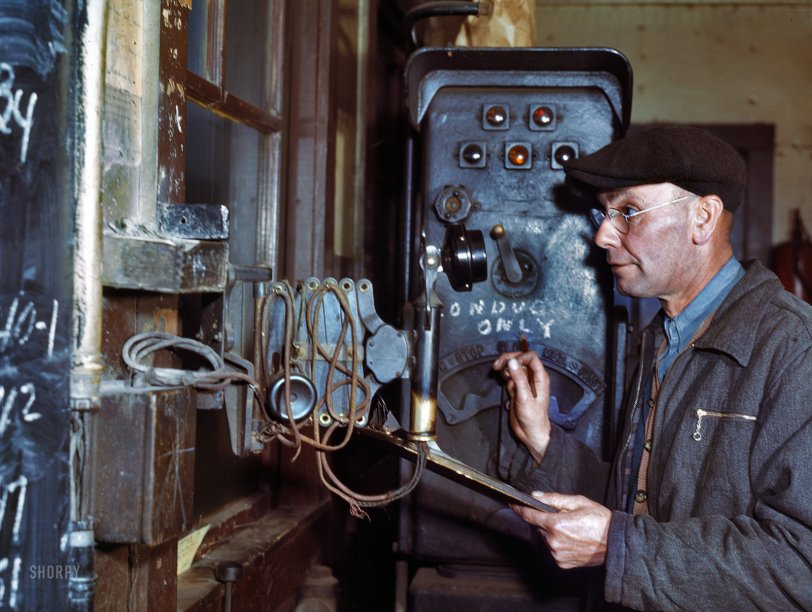


Framed or unframed, desk size to sofa size, printed by us in Arizona and Alabama since 2007. Explore now.
Shorpy is funded by you. Patreon contributors get an ad-free experience.
Learn more.

- Lofty addition
- In 1912
- Keenan Building
- Six years old
- Taken from the P.J. McArdle Roadway?
- It stood only 47 years
- Three track mind
- Incline to the right
- Reach for the sky, 1912 style
- No clean sweep
- Same Job Title, Same Face
- Sadly Lost
- Beautiful ...
- Where you get your kicks
- Aim High
- Pueblo Revival sisters
- Pueblo Neoclassicism
- Milk Man
- Regional dialect.
- Spielberg's inspiration
- Great Photo
- Loaf Story
- Do you still have the Rakes category?
- Could almost be a scene from the 1957 movie 'Hell Drivers'
- The Wages of Fear.
- Conspicuous by their absence
- Got Milk?
- All that aluminum
- No lefties
- Smoke 'em if you've got 'em
Print Emporium
The Hump Master: 1942

Chicago, December 1942. "Hump master in a Chicago & North Western railroad yard operating a signal switch system which extends the length of the hump track. He is thus able to control movements of locomotives pushing the train over the hump from his post at the hump office." 4x5 Kodachrome transparency by Jack Delano for the Office of War Information. View full size.
I had to find out
The Fast Freight Rides the Hump from Popular Mechanics, March 1940.
Humping by Telephone
In the sixties when I worked for Mother Bell in New Haven, I would get called out at least weekly during the late night/early morning hours to fix some trouble in the telephone system in use at "The Hump". The NYNH&H RR (later Penn Central) had some of the oldest telephone equipment in existence, and it was how they coordinated all the hump movements between towers. It was always very cool to stand in one of the towers and watch all the freight cars coming over the hump and descending through "the ladder" to be mixed on one of innumerable tracks in the huge yard.
RF Railcar ID
In our area, at least, RF (radio frequency) tags replaced bar codes some time ago for railcar identification by the Union Pacific Railroad.
Bar codes
Bar codes are now used in humping operations. Computers read the codes as cars begin their roll down the hump (or on the way up), retrieve car information from a database, calculate the necessary momentum the car needs to properly attach to the growing train, and the retarders are applied automatically.
It's amazing to watch from a distance, with cars moving here and there to their respective destinations, retarders creating screeching noises as they press against the wheel flanges.
Hump on my signal
In the fourth image down in this posting you'll see this picture and another which explains the operation. The lever he has his hand on does nothing more than control the signal aspects displayed to the engineer of the hump locomotive. There's a second operator, shown in the other photo, who controls both the turnouts and the retarders; they both have a copy of the same list, whose content you can see in the second picture, which gives information on each car, in order, as to weight and destination.
Retarder Controller?
I suspect the control the hump master is using is actually the retarder controller-slowing down the car(s) as it rolls down the hump. The clipboard he holds would have the weight/contents of each car (or group of cars, called a 'cut'). His job was to regulate the speed of each, so they rolled just far enough, but not TOO far. His job was probably 55% art, 40% science, and 5% luck back then, given the varied rolling resistance of freight cars from different RR's.
He's a what?
He would have been great on "What's My Line?"
























On Shorpy:
Today’s Top 5